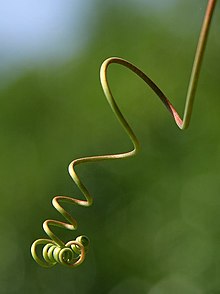卷鬚
捲鬚泛指部份攀綠植物上由葉或莖變形而成、有纏繞特性的器官。具有向觸性反應[1]。依據發育來源的不同,可分為莖卷鬚(如黃瓜和西瓜)、葉卷鬚(如豌豆)、葉柄卷鬚(如豬籠草)和花序卷鬚(如金魚草和葡萄)[2]。不同類型卷鬚的附着和纏繞機制都不相同[3]。生長素和乙烯等植物激素對植物卷鬚的纏繞有很大作用[1]。

解剖學概述
編輯植物學定義中,捲鬚可能源自特化的莖、葉、葉柄或同時包含兩種以上部位,為線狀,攀緣植物用它來支撐和附著,在寄生植物如菟絲子以用來侵入宿主[4]。捲鬚通過捲曲、纏繞或粘附來固定至合適的結構上。捲鬚的大小不一,哈里亞納豬籠草的捲鬚大小從幾厘米到27英寸(69厘米)不等[5],栗藤(Tetrastigma voinierianum)的捲鬚最長可達20.5英寸(52厘米)。大多數植物每個節上只有一根簡單或分枝的捲鬚,但土豚黃瓜(Cucumis humifructus)可以有多達八根[6]。
在豌豆中,只有末端的小葉被修飾成捲鬚。在黃紫雲英(Lathyrus aphaca)等其他植物中,整個葉子被修飾成捲鬚,改由托葉變大並進行光合作用。還有一些使用複葉的軸作為捲鬚,例如鐵線蓮屬的成員。
豬籠草特化的捕蟲籠就是在捲鬚的末端形成的,若捲鬚的中段與物體接觸的時間夠長,它會捲曲在物體周圍,為攀爬的植株提供一個牢固的錨定[7]。寄生植物菟絲子的捲鬚由空氣中的化學物質引導,並且只纏繞在合適的宿主周圍。
一個用捲鬚位置判斷植物所屬類群的口訣是「豆端、葡對、瓜側、 西腋、菝柄」:豆科是羽狀複葉末端的小葉特化,葡萄科是與葉對生的花序特化,葫蘆科的捲鬚與葉腋90度側生,西番蓮科是互生葉的腋芽特化,菝葜科是由葉柄上長出一對捲鬚。
進化
編輯透過攀爬,植物可以到達樹冠接收更多的陽光,研究發現演化出此能力的分類群有較高物種數量,顯示攀爬是一種成功的創新[8]。
捲鬚是透過趨同演化而出現的植物器官,由莖、葉、花序等多種不同來源的結構演化而來。基於捲鬚發育的分子基礎,研究表明捲鬚的螺旋生長性能與個體發育起源無關[9],相反,存在多個個體發生起源。根據個體發育起源和生長模式,已鑑定出17種類型的捲鬚,並且每種類型的捲須在被子植物中都可以參與不止一次[10]。
捲繞機制
編輯轉頭運動
編輯捲鬚捲繞的機制始於捲鬚的轉頭運動,捲鬚圍繞其軸以圓形振盪模式移動和生長[12]。這是捲鬚的第一個主要運動,目的是讓捲鬚接觸到可以爬的東西[13]。如果沒有找到可以抓附的目標,捲鬚將向著光源進行轉頭運動。在多次嘗試到達支撐結構後,捲鬚最終會掉到地上[14]。值得注意的是,此轉頭運動並非捲鬚植物所獨有[14] ,幾乎所有植物都有此行為[12]。
接觸後卷繞
編輯向觸性是讓捲鬚開始捲繞的主要信號。例如,豌豆捲鬚在曝露的細胞壁表面具有高度敏感的細胞,這些細胞會啟動接觸信號,通常是鈣波[15]。接觸信號誘導其他植物激素的信號級聯,最重要的是γ-氨基丁酸(GABA)和茉莉酸(JA)。在葡萄藤捲鬚中,GABA可以獨立促進捲鬚捲曲,JA可作為啟動捲鬚捲曲的激素信號[16]。該級聯可以激活質膜上的質子通道,改變細胞膜內外的滲透壓,導致膨壓的改變;由於卷鬚內外側膨壓的不同,而產生捲曲反應[17]。卷繞的發生也部份源自厚壁細胞的膠質木纖維(gelatinous fiber),在收到接觸信號後會收縮和木質化[18]。
自我排斥
編輯儘管捲鬚基於觸覺纏繞在宿主上,但一些攀綠植物已被發現能避免纏繞自己或同種植物上——這表明基於化學感受的趨化性[19][20]。一旦捲鬚與鄰近的同種植物(同一物種)接觸,宿主植物釋放的信號分子就會與攀緣植物捲鬚上的化學感受器結合。這會產生一個信號,阻止觸變性通路,從而防止捲鬚纏繞在宿主週圍[19]。
對攀緣植物烏蘞莓進行的研究發現,當兩株烏蘞莓接觸時,卷鬚不會纏繞在同種植物週圍。研究人員從烏蘞莓的葉子中分離出草酸鹽晶體塗在棒上,結果發現鳥蘞莓的捲鬚在接觸此棒子時不會捲曲,證實了攀緣植物使用化學信號進行自我辨別[20]。
自我排斥可能賦予攀緣植物進化優勢,因為與更堅硬的物體相比,其他攀緣植物無法提供穩定的盤繞結構。此外,避免盤繞在同種植物週圍,可減少同類競爭,而獲得更多資源,從而實現更好的生長[19]。
研究歷史
編輯最早對捲鬚做較全面研究的是查爾斯·達爾文,在1865年出版了《論攀緣植物的運動和習性》。該著作創造了「轉頭運動」(circumnutation)一詞來描述生長中的莖和捲鬚尋求支撐的運動。達爾文還觀察到捲繞時會發生的捲鬚倒錯(tendril perversion)現象,即捲鬚的前後兩段是以相反的方向螺旋,中間會有一個連接點[21]。
-
萊佛士豬籠草的上位籠有盤繞的捲鬚
-
黃瓜捲鬚
-
南瓜藤盤繞的捲鬚
參考文獻
編輯- ^ 1.0 1.1 Li, Binqi; Yan, Jiahui; Li, Hao; Xin, Wei; Tian, Yunhe; Yang, Zhenbiao; Tang, Wenxin. Changes of Small GTPases Activity During Cucumber Tendril Winding. Chinese Bulletin of Botany. 2022-05-01, 57 (3): 299. doi:10.11983/CBB22058.
- ^ Sousa-Baena, MS; Sinha, NR; Hernandes-Lopes, J; Lohmann, LG. Convergent Evolution and the Diverse Ontogenetic Origins of Tendrils in Angiosperms.. Frontiers in plant science. 2018, 9: 403. PMID 29666627. doi:10.3389/fpls.2018.00403.
- ^ Bowling, AJ; Vaughn, KC. Structural and immunocytochemical characterization of the adhesive tendril of Virginia creeper (Parthenocissus quinquefolia [L.] Planch.).. Protoplasma. 2008, 232 (3-4): 153–63. PMID 18421549. doi:10.1007/s00709-008-0287-x.
- ^ Plants: A Different Perspective. content.yudu.com. [2018-01-09]. (原始內容存檔於2017-02-17) (英語).
- ^ Kurata, Shigeo. Nepenthes of Mount Kinabalu. Kota Kinabalu, Malaysia: National Parks Trust. 1976: 47.
- ^ Kilbride Jr., Joseph H. Biosystematic Monograph of the Genus Cucumis. Bonne, No. Carolina: Parkway Publishers. 1993: 77.
- ^ Clarke, C.M. 1997. Nepenthes of Borneo. Natural History Publications, Kota Kinabalu.
- ^ Gianoli, Ernesto. Evolution of a climbing habit promotes diversification in flowering plants. Proceedings of the Royal Society of London. Series B: Biological Sciences. 2004-10-07, 271 (1552): 2011–2015. PMC 1691831 . PMID 15451690. doi:10.1098/rspb.2004.2827.
- ^ Sousa-Baena, Mariane S.; Lohmann, Lúcia G.; Hernandes-Lopes, José; Sinha, Neelima R. The molecular control of tendril development in angiosperms. New Phytologist. 2018, 218 (3): 944–958 [2023-03-09]. ISSN 1469-8137. PMID 29520789. S2CID 4860319. doi:10.1111/nph.15073. (原始內容存檔於2022-06-23) (英語).
- ^ Sousa-Baena, Mariane S.; Sinha, Neelima R.; Hernandes-Lopes, José; Lohmann, Lúcia G. Convergent Evolution and the Diverse Ontogenetic Origins of Tendrils in Angiosperms. Frontiers in Plant Science. 2018, 9: 403. ISSN 1664-462X. PMC 5891604 . PMID 29666627. doi:10.3389/fpls.2018.00403 (英語).
- ^ Isnard, Sandrine; Feild, Taylor S., The evolution of angiosperm lianescence: a perspective from xylem structure-function, Ecology of Lianas (John Wiley & Sons, Ltd), 2015: 221–238 [2021-06-05], ISBN 978-1-118-39240-9, doi:10.1002/9781118392409.ch17, (原始內容存檔於2021-06-05) (英語)
- ^ 12.0 12.1 Kiss, John Z. Plants circling in outer space. New Phytologist. 2009, 182 (3): 555–557 [2023-03-09]. ISSN 1469-8137. PMID 19422543. doi:10.1111/j.1469-8137.2009.02817.x. (原始內容存檔於2022-06-23) (英語).
- ^ Malabarba, Jaiana; Reichelt, Michael; Pasquali, Giancarlo; Mithöfer, Axel. Tendril Coiling in Grapevine: Jasmonates and a New Role for GABA?. Journal of Plant Growth Regulation. 2019-03-01, 38 (1): 39–45. ISSN 1435-8107. S2CID 13792885. doi:10.1007/s00344-018-9807-x. hdl:21.11116/0000-0001-1BB3-7 (英語).
- ^ 14.0 14.1 Guerra, Silvia; Peressotti, Alessandro; Peressotti, Francesca; Bulgheroni, Maria; Baccinelli, Walter; D』Amico, Enrico; Gómez, Alejandra; Massaccesi, Stefano; Ceccarini, Francesco; Castiello, Umberto. Flexible control of movement in plants. Scientific Reports. 2019-11-12, 9 (1): 16570. Bibcode:2019NatSR...916570G. ISSN 2045-2322. PMC 6851115 . PMID 31719580. doi:10.1038/s41598-019-53118-0 (英語).
- ^ Jaffe, M. J.; Leopold, A. C.; Staples, R. C. Thigmo responses in plants and fungi. American Journal of Botany. 2002-03-01, 89 (3): 375–382. ISSN 0002-9122. PMID 21665632. doi:10.3732/ajb.89.3.375 (英語).
- ^ Malabarba, Jaiana; Reichelt, Michael; Pasquali, Giancarlo; Mithöfer, Axel. Tendril Coiling in Grapevine: Jasmonates and a New Role for GABA?. Journal of Plant Growth Regulation. March 2019, 38 (1): 39–45. ISSN 0721-7595. S2CID 13792885. doi:10.1007/s00344-018-9807-x. hdl:21.11116/0000-0001-1BB3-7 (英語).
- ^ Jaffe, M. J.; Galston, A. W. Physiological Studies on Pea Tendrils. V. Membrane Changes and Water Movement Associated with Contact Coiling. Plant Physiology. 1968-04-01, 43 (4): 537–542. ISSN 0032-0889. PMC 1086884 . PMID 16656803. doi:10.1104/pp.43.4.537 (英語).
- ^ Bowling, Andrew J.; Vaughn, Kevin C. Gelatinous fibers are widespread in coiling tendrils and twining vines. American Journal of Botany. April 2009, 96 (4): 719–727. PMID 21628227. doi:10.3732/ajb.0800373 (英語).
- ^ 19.0 19.1 19.2 Fukano, Yuya; Yamawo, Akira. Self-discrimination in the tendrils of the vine is mediated by physiological connection. Proceedings of the Royal Society B: Biological Sciences. 26 August 2015, 282 (1814): 20151379. PMC 4571702 . PMID 26311669. doi:10.1098/rspb.2015.1379.
- ^ 20.0 20.1 Fukano, Yuya. Vine tendrils use contact chemoreception to avoid conspecific leaves. Proceedings of the Royal Society B: Biological Sciences. 15 March 2017, 284 (1850): 20162650. PMC 5360923 . PMID 28250182. doi:10.1098/rspb.2016.2650.
- ^ Charles Darwin, "On the movements and habits of climbing plants", Journal of the Linnean Society, 1865.